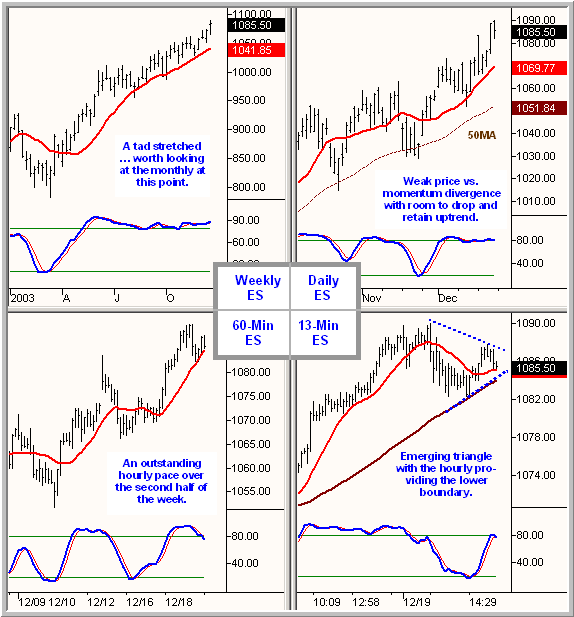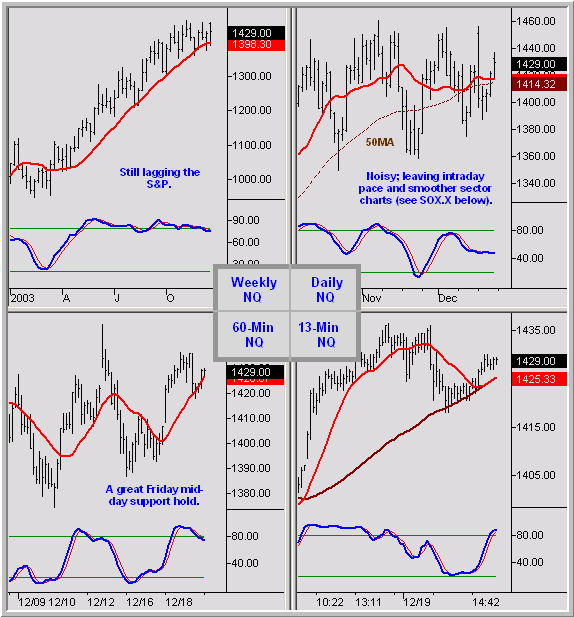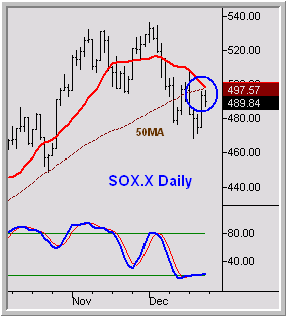Discretionary Vs. System Trading
I’m not sure where to start
tonight except to say what a trading week!
Bookended by Monday’s gap ’em up Saddam effect
(complete with a full-day pullback to daily support that likely bugged the heck
out of intraday bottom pickers) and Friday’s quadruple-witching activity, the
markets provided ample trading opportunity and volatility, despite seeing the
VIX.X drop to seven-year lows midweek.
For the record and week, a 12-point gain sent the S&P to new 2003 highs, while
the lagging Nasdaq managed to eke out a 7-point bump. Both markets were
highlighted by strong hourly paces both early and late in the week, and while
the Nasdaq daily chart looks a bit like a spirograph doodle (an oldie but
goodie toy that my fellow 40-somethings can relate to), the narrower SOX.X
daily chart — posted below our standard index charts — has been providing a
picture-perfect pace.
Let’s hit the charts and then talk a bit about my thoughts on discretionary vs.
system trading.
S&P 500

Nasdaq

Moving Avg
Legend: 15MA
Larger Timeframe 15MA
See https://www.donmillertrading.com
for Setups and Methodologies
Charts © 2003 Tradestation

Discretionary vs. System Trading
Those that have followed me over the years know that I am a strong advocate of
trading (and therefore
teaching) based on a combination of technical analysis and human judgment,
vs. trading an outright mechanical system. Now before my inbox floods with mail
from system traders sharing opposing views, there of course is no right or wrong
approach and system trading is certainly a viable option for those choosing such
a road.
Yet my personal preference and beliefs will always remain skewed toward the
significant importance of the human judgment factor in making decisions, which
in my view includes both a comprehension of multiple technical indicators and
frankly, experience.
Much has, of course, been written about the pros and cons of both approaches,
and it certainly isn’t my intent or desire to get into a prolonged pro/con
dialogue — except to talk about why I’ve chosen the discretionary road, along
with some similarities between the two approaches in my own trading.
I could begin by telling you that I’m a control freak (which is true to a
degree), and leave it at that. I could also tell you that I enjoy the challenge
of having to make constant decisions on a daily basis, which would also be true.
In fact I remember as a child that I loved doing brain-teasers and puzzles of
all kinds, including double-sided jigsaw puzzles. And of course I chose to leave
a well-compensated executive corporate position years ago to pursue this crazy
business because I had lost the daily “challenge”.
And while all of these aspects are true, this week’s trading reinforced my
preference by providing a few key significant market and non-market events that
required balancing human decision making with the standard technicals — which
E-Mini students know
is a fairly simple combination of trend, momentum, and range indicators. Of
course, I’m referring in part to the impact that Saddam’s capture had on market
action which required a bit of human judgment in terms of how to manage existing
positions or enter new ones.
Such an event further reminded me of the key of size management in successful
trading — another aspect which, in my view, requires sound judgment no system
can provide. Even for an intraday scalper, a properly managed position when
everything lines up — including the human judgment aspect — can make or break
a month, quarter, or yes, even a year.
Yet as I mentioned earlier, there can still be similarities between system and
discretionary trading. For example, as I mentioned at TM’s Las Vegas convention
a few years back, I typically track a handful of personal performance measures
including days profitable, total gains / losses (call it a risk/reward ratio of
sorts), and net bottom line. And like our three technical indicators, each
measure is completely irrelevant without the other two. My main concern
should be obvious — bottom line. Yet the profitable % and gain/loss figures
provide me with two important performance benchmarks that aren’t totally unlike
their system cousins.
Specifically, I have a personal target performance goal of 80% days profitable
and a 2.5 gain / loss ratio. Now I’m not suggesting these are ideal figures, as
they simply reflect my current personal objectives. And while I’ll again stress
that each one is completely meaningless without the other (i.e., 90% means
absolutely nothing when negated by one large brain cramp), each does provide a
clue into consistency of approach. And by recording and reviewing performance
results over time, the figures provide a “confidence probability” factor that
could easily be compared to a backtested system probability factor. In other
words, I know over time that I’ll be “on my game” X% of the time and that
provides me with the confidence to enter each trading day.
Of course in the case of a discretionary trader, the percentage and ratio will
reflect more than simply correctly applying technical analysis, for it will also
include factors over the course of time such as effective size selection,
available market liquidity, order entry skill, personal focus, and so on. And in
the end, I’ve found reliance on such measures nothing short of critical during
those times when performance slips or slumps.
Admittedly, perhaps one reason many choose to pursue the holy system grail is
because the road to developing one’s “confidence probability” factor can be
painfully long and difficult. For doing so requires a tremendous degree of sweat
and toil in becoming a self-sufficient trader which, frankly, most won’t
pursue. Yet if and when such a personal benchmark evolves to a satisfactory
level, you’ll find an inner feeling of confidence that no system can ever
provide — an ability to rely on one’s self in all times, markets, and
conditions.
Good Trading and Have a
Great Weekend!
